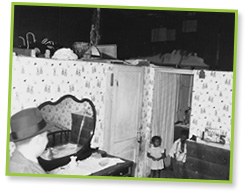Where the Neighborhood Ends
High School: Grades 9–12
Story
Page: 1 | 2 | 3 | 4 | 5 | 6 | 7 | 8 | 9
"The court can force whites to let Negroes move in," Lane thought, "but it can't keep racists from moving out."
Beneath the restriction agreement, Lane found several photographs. Two pictured men examining crumbling buildings. Wallpaper hung down like macabre holiday decorations, exposing brick and bare wood. Lane flipped through more photos: a filthy bathroom, a kitchen without plumbing, a bedroom with the upper half of the partition walls missing. Everything was dark, stained, and ugly. On the back of each photo, Henry had pasted a label giving a date and address. Most of the photos had been taken near the borders of Hyde Park in 1953. The men examining the buildings were city inspectors, Lane learned. He wondered if the photos were propaganda pictures because all the inspectors were white, but all the residents were black children. Following these photos was an inspection notice. Cobie and Esau's landlord had probably received one just like it.
The last photograph portrayed the demolition of condemned buildings. "And that's how the story ends," Lane said to himself. "The city tears down the old neighborhood to make way for a new one." Hearing his parents enter the house, Lane carefully straightened the stack of photos and documents, slipped them back into the folder, and went into the dining room.
"Henry, would you please repair the backyard gate tomorrow?" Lydia Jane asked her husband during dinner. "Could you take out the gate and fence the opening? I heard there's a prowler in Hyde Park."
"You probably heard a rumor started by the blockbusters," Henry replied, "but I'll do the job first thing in the morning. In the afternoon, I plan to call on a few local businessmen." He explained that a community group was proposing a redevelopment plan for sections of Hyde Park. "I agreed to rally support for the plan," Henry continued, "but I'm also trying to convince the group to add a building or two for low-income residents."
"Public housing? Here? In Hyde Park?" Lane's mother struggled to control the alarm in her voice.
"Public housing is the solution. If the city of Chicago provides enough comfortable, affordable places to live, landlords won't have any poor tenants to exploit, and the slums will disappear," Lane's father reasoned. "We'll start the cleanup on the southwestern edge of Hyde Park, along Cottage Grove Avenue between 55th Street and 56th Street."
Lane's throat burned; he gulped ice water but his words still smoldered. "Do you realize most of the people living on that block are Negroes? Cobie and Esau just moved there because the city ripped down their building. Where will they go now?"
"You mean Jacob and Esau Faris? The boys you met when I took you along to visit my client this summer?" Henry looked closely at his son. "Well, now you see why we need public housing. The Faris family is a case in point—a family forced to live in a basement because they can't afford anything better."
Downloads (pdf)


